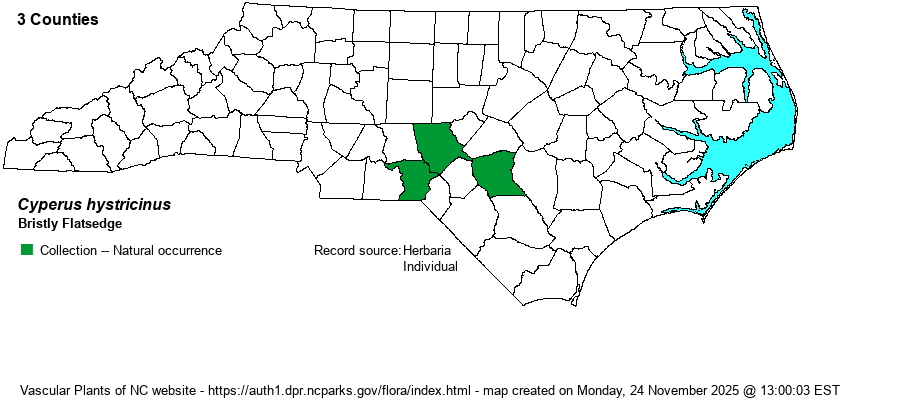| Author | Fernald | |
| Distribution | Thus far, known only from the Sandhills region and lowermost Piedmont. It should also occur in the Coastal Plain. Only annotated specimens are accepted here.
Mostly Coastal Plain, NJ to GA and eastern TX; inland to AR and MO. Only a few records in most states. | |
| Abundance | Rare, but curiously so, as there is plenty of suitable habitat. In NC known from just 4 locations, one as late as 1998, another in 2020 (Moore Co.), and one in 2025 (Richmond Co.). This is now on the NCNHP's Significantly Rare list and is ranked as S1. The 2025 Richmond County population supported at least 20 plants. | |
| Habitat | Specimens from Cumberland and Richmond counties were taken from Longleaf Pine savannas and uplands; specimens from Moore County (2020) were from a grassy road alongside a disused railroad in the Piedmont. Weakley's (2018) habitats are more generalized: "Dry woodlands and forests" and thus not overly helpful in searching for it. The 2025 Richmond County site was burned earlier that same year and appeared to promote germination. |
| Phenology | Flowering and fruiting mid June-September. | |
| Identification | This is a tall flatsedge with a "starburst" array of widely spreading flowering stalks at the top of the stem. From relatives C. plukenetii and C. retrofractus, it is told by the glabrous stem (vs. minutely rough). Also, its spikes are narrowly cylindrical and not enlarged at the end. | |
| Taxonomic Comments | Confusion in the past with C. retrofractus has obscured the distribution of C. hystricinus. Specimens of both need careful ID check. A synonym is C. retrofractus var. hystricinus.
The genus Cyperus is mostly tropical and warm-temperate in distribution; thus, in NC it is much commoner in the Coastal Plain than in the Mountains and Piedmont. Most species have 1-few flowering stems (culms) from grasslike basal leaves, plus a few stem leaves. At the summit is an inflorescence of very open and branched, or tightly packed, spikes, varying among species from brown to golden brown to straw-color to reddish. The arrangement of the spikelets is important, whether like a hand (digitate) or in paired or alternate rows (pinnate); as is the shape of the achene (seed), whether bi-convex in cross-section or triangular. As a group, Cyperus tends to be weedy and readily enters disturbed ground; this is true for many natives as well as all the aliens. In recent years, following DNA research, the genus has incorporated several genera that in RAB (1968) or other manuals were separate: Hemicarpha, Lipocarpha, and Kyllinga. | |
| Other Common Name(s) | None | |
| State Rank | S1 | |
| Global Rank | G4 | |
| State Status | SR-T | |
| US Status | | |
| USACE-agcp | | |
| USACE-emp | | |

